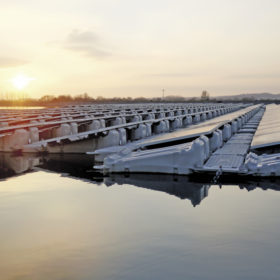
An international research team has claimed that thin-film modules are an ideal solution for floating PV projects in offshore locations, mainly due to their superior hydrodynamic properties. The scientists have also said that direct contact between installations and the water provides additional self-cooling opportunities, while keeping the waterproof modules clean. Such arrays could potentially withstand higher waves and the difficult environmental conditions of the open sea.
Scientists from Italy’s University of Naples Federico II and India’s M.Kumarasamy College of Engineering have recommended thin-film solar module technologies for floating PV projects at offshore sites and onshore remote ares. Lightweight thin-film panels are indicated as an efficient alternative for projects with highly complex logistical requirements in terms of transport, installation time frames, and the need for infrastructure.
The researchers have also claimed that projects based on thin-film panels have the advantage of being in direct contact with water, which can provide additional opportunities for self-cooling and the self-cleaning of panels. However, the main disadvantage of thin-film arrays, compared to projects built on pontoons, is the lower light absorption they offer, they said.
A floating PV system that relies on thin-film PV can be described as a single scalable array of panels linked by connectors, either in series or parallel to each other, based on a project’s capacity. The thin-film panels used in floating projects are usually laminated with a highly transparent waterproof polymer. Air pockets and ducts are embedded in panels during the lamination process in order to reduce rigidity and buoyancy.
Such arrays could be ideal solutions for offshore projects, which are subject to harsh external environmental forces such as strong winds and high waves, the researchers said. “Analyses based on the flexural rigidity have proved that the thin film technology-based FPV on offshore will tend to have low wave energy interaction,” they said in their new paper, “Floating Photovoltaic Thin Film Technology—A Review,” which was recently published in Intelligent Manufacturing and Energy Sustainability.
The researchers explained that the hydrodynamic properties of thin-film panels can reduce mechanical stress on mooring systems. This means that less infrastructure is required, so the logistics of projects are simpler than those of projects that are based on conventional crystalline silicon panels and pontoons, which require aluminum frames and structures to resist saltwater corrosion.
The researchers have also complied a detailed review of existing thin-film technologies that could be adopted in floating PV installations. They include amorphous silicon (a-Si), cadmium telluride (CdTe), copper, indium, gallium and selenium (CIGS), and gallium arsenide (GaAs).
Lắp đặt điện mặt trời Khải Minh Tech
https://ift.tt/2X7bF6x
0906633505
info.khaiminhtech@gmail.com
80/39 Trần Quang Diệu, Phường 14, Quận 3
Lắp đặt điện mặt trời Khải Minh Tech
https://ift.tt/2ZH4TRU
Không có nhận xét nào:
Đăng nhận xét